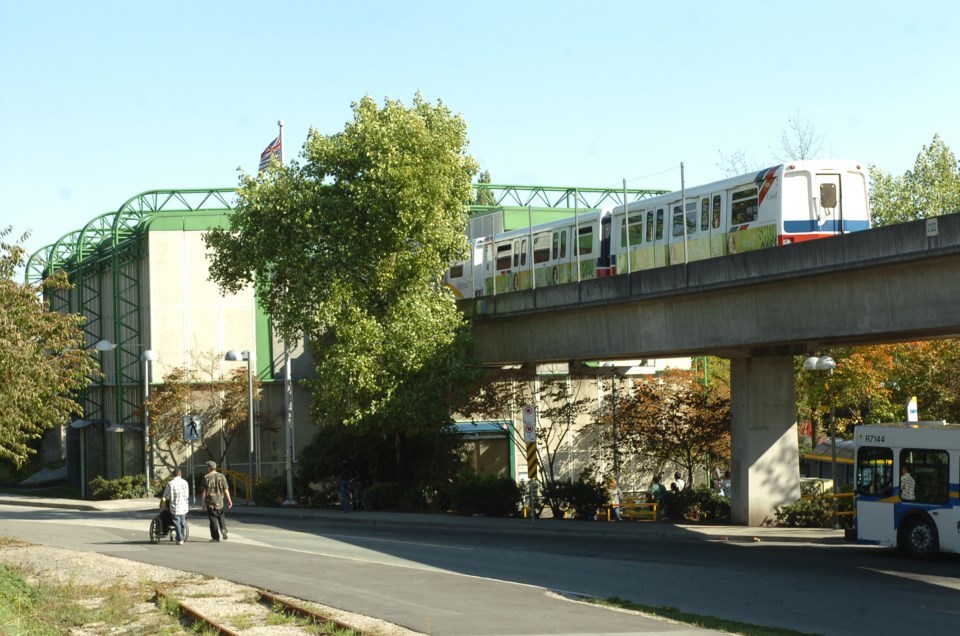The City of New Westminster will soon be seeking ideas about the vision for the area around the 22nd Street SkyTrain station.
City council recently received an update from staff on collaboration that’s been taking place with First Nations and plans for community engagement that’s coming up related to developing a vision for the 22nd Street station area. It’s all part of the city’s plan to create a climate-friendly neighbourhood around the SkyTrain station.
While the city continues to engage with First Nations on the initiative, it’s also getting set to hold a public launch event on Wednesday, Oct. 11 at Anvil Centre. That event is expected to include a panel of speakers and an interactive opportunity for dialogue.
“Because the vision for 22nd Street station area has relevance across the city, the launch event is being planned to be held at an easily accessible venue, Anvil Centre,” said a staff report. “Additional events will be held within the Connaught Heights neighbourhood, including pop-up engagement and a workshop for residents, to which the Connaught Heights and West End residents’ associations will also be invited.”
An “ideas challenge” that will get underway in early October will seek feedback on: What is your big, bold idea for a climate-friendly neighbourhood where everyone can thrive? Input will be sought on themes, including: landscape and water; mobility, access and infrastructure; buildings and energy; land use and housing; and community connection and identity.
“There are anticipated to be multiple ‘winning’ ideas, with honorariums for some of the submissions rated highest by a jury,” said a staff report. “The concept of the ideas challenge is to harvest a range of ideas from residents as well as leaders from outside of the community.”
Coun. Daniel Fontaine said he’s pleased to see the work that’s happening around engagement with First Nations. He questioned what the timeline looks like for getting into the “meat” of the planning process.
Jackie Teed, the city’s acting director of climate action, planning and development, said the visioning part of the process is underway and the aim is to complete that work this year.
“Once the visioning process is done, then we would have to go into a more technical planning process, which is where we would create the actual neighbourhood plan, land-use designations and those components,” she said. “We are in the early stages of the first visioning phase.”
Ideas challenge coming
Meredith Seeton, a senior policy planner, said many engagement opportunities are happening in October.
“We are anticipating that our ideas challenge will be open from November until the new year, and then we’d be moving into really building on what we have heard,” she said. “We can circle back and share that with council about the details about what we heard through that community engagement and ideas- generating process.”
Seeton said the following phase would focus on building a draft vision, with more consultation being conducted to get input on that vision. She said staff expect to bring a plan to council for its endorsement towards the end of 2024.
“I’m really keen to see this work moving forward. It’s been a long time coming,” said Coun. Nadine Nakagawa. “It’s going to be a really big change for that neighbourhood. So I’m wanting to ensure we are in constant communication with residents there about what’s coming up because I know a lot of folks are waiting for this very, very eagerly.”
While the process was “derailed” because city staff had to respond to the global pandemic, Nakagawa said she is excited to see it’s now underway and is enthusiastic about the way it’s rolling out.
“I am really grateful for the work and the reaching out to First Nations and involving them in conversation very, very early on,” she said.
The City of New Westminster had planned to launch the planning process for this neighbourhood in 2020, but it was delayed by the COVID-19 pandemic and staffing challenges. In June 2023, council directed staff to relaunch the process and to focus on climate action and closer collaboration with First Nations.
Seeton said the city has had a lot of good, constructive conversations with some First Nations, but it’s been harder to connect with others. She said staff is committed to ensuring they have opportunities to stay up-to-date on the process and to weigh in and be part of the conversation.
“There is particular interest in being at the table when the design workshop and charrette process in early , when sort of pencil is hitting paper and when we are talking about what we have heard and how do we integrate that with what First Nations’ priorities are and what’s going to be feasible in the context,” she said.
According to a staff report, First Nations staff (not chiefs or councils) have expressed an interest in exploring opportunities for economic reconciliation, such as by facilitating the creation of First Nations-owned and operated housing within the station area. The report noted that interest has also been expressed in opportunities for cultural recognition – making the Coast Salish context of the lands more visible, through approaches like informing the design concept, exploring wayfinding and public art, and creating space for gatherings and ceremony.




